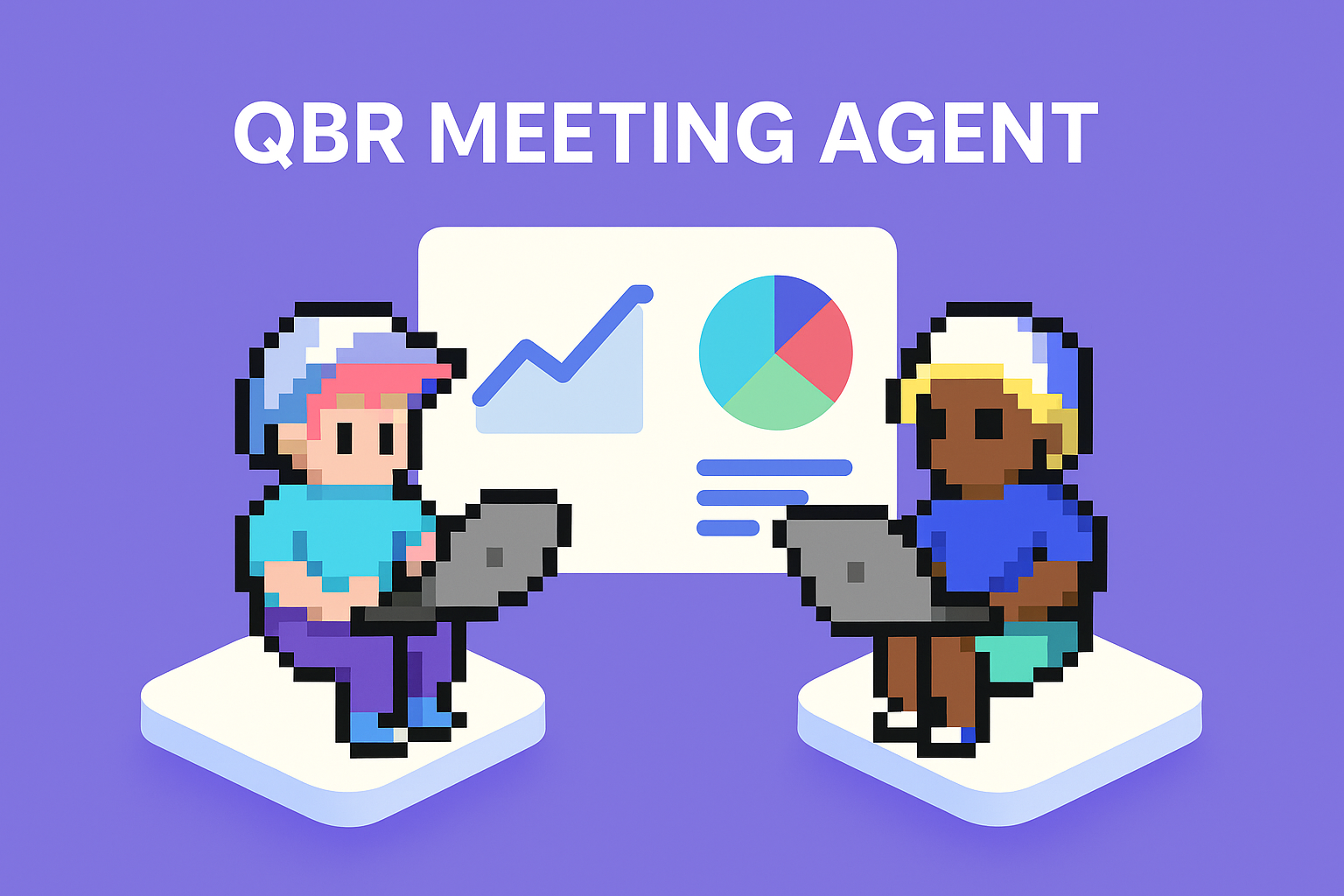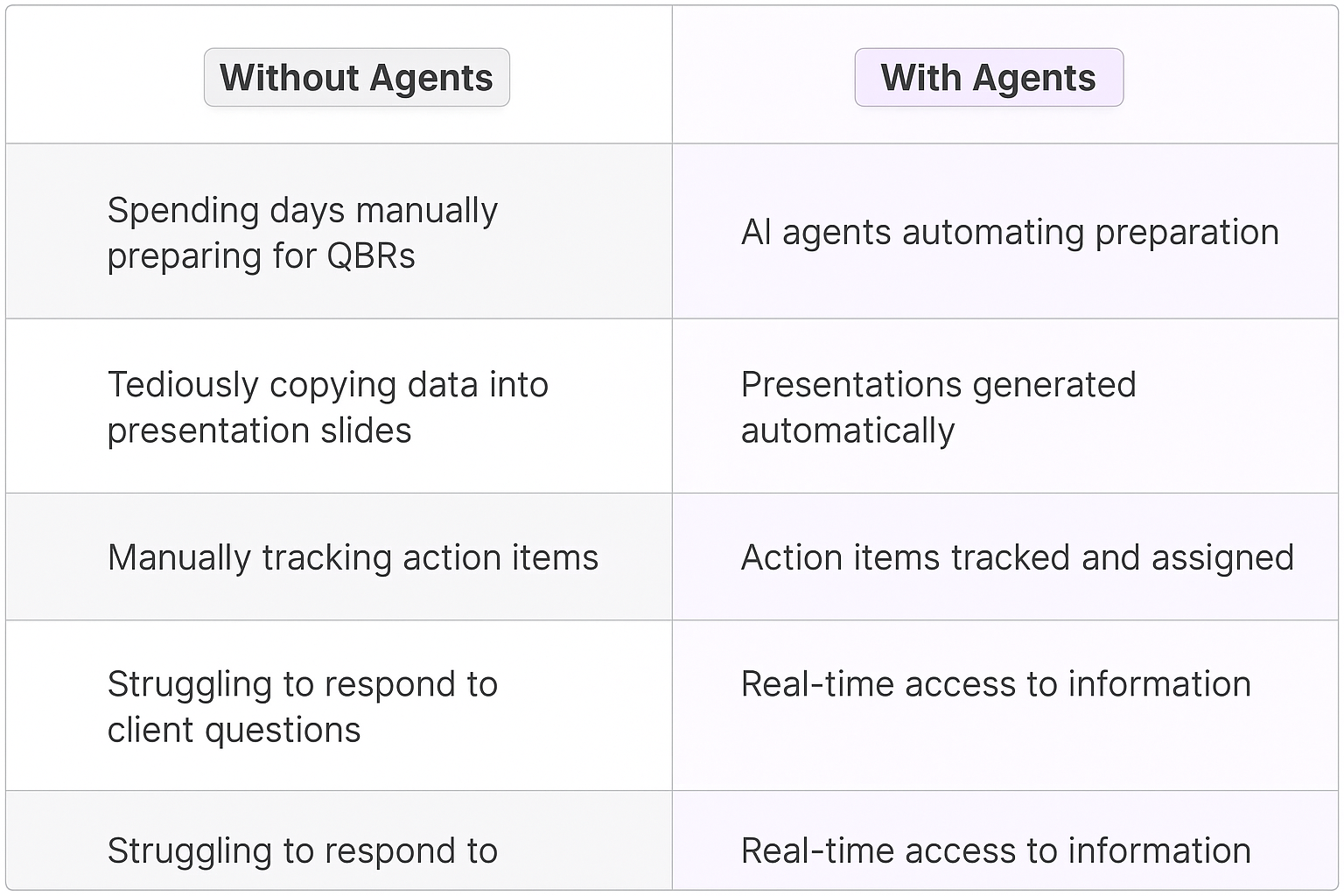
AI-powered meeting planner agents are revolutionizing how Experience Design Managers prepare for and conduct QBRs. These agents automate data analysis, presentation creation, and action item tracking, allowing managers to focus on strategic discussions and relationship building. This technology streamlines workflows, enhances client communication, and drives better business outcomes.
Before Meeting
Your AI agent automatically compiles performance dashboards, analyzes client usage patterns, and identifies key insights related to user experience. You walk into the meeting with a data-driven presentation ready to showcase the impact of your design strategies.
During Meeting
As client questions arise, your AI agent provides real-time access to relevant data and insights, enabling you to respond with confidence and address concerns effectively. The agent can also track action items and assign follow-up tasks.
After Meeting
Post-meeting, your AI agent generates a summary of key discussion points, action items, and next steps. It monitors the progress of assigned tasks and provides updates, ensuring accountability and driving continuous improvement in user experience.
What you’ll need
You don't need to be a developer to set up this integration. Follow this simple guide to get started:
- Meeting Notetaker Agent template
- Calendar account
- Meetings to join
- Relevance AI Account

Who this agent is for
This agent is designed for Experience Design Managers, UX Directors, Product Managers, and anyone responsible for presenting user experience data and insights to clients or stakeholders during Quarterly Business Reviews (QBRs). It's ideal for individuals and teams who need to demonstrate the value of their design strategies, align on future goals, and foster strong client relationships. Whether you're a manager at a large agency or a solo consultant, this agent simplifies QBR preparation and ensures you deliver impactful presentations.
How this agent makes QBR planning easier
Automate data collection and data analysis
Instead of manually compiling data from various sources, the agent automatically gathers and analyzes key user experience metrics, saving you hours of preparation time.
Generate executive-ready presentations
The agent creates visually appealing and data-driven presentations that highlight key insights and demonstrate the impact of your design strategies.
Identify growth opportunities
The agent analyzes client usage patterns and identifies potential areas for improvement, enabling you to proactively suggest solutions and drive business growth.
Track action items and follow-up tasks
The agent automatically tracks action items from previous QBRs and assigns follow-up tasks, ensuring accountability and driving continuous improvement.
Benefits of AI Agents for Experience Design Managers
What would have been used before AI Agents?
Experience Design Managers traditionally relied on manual data collection, spreadsheet analysis, and presentation creation to prepare for QBRs. This process was time-consuming, prone to errors, and often resulted in last-minute scrambles to gather the necessary information. They would spend valuable time wrangling data instead of focusing on strategic insights and client communication.
What are the benefits of AI Agents?
AI agents offer a streamlined and automated approach to QBR preparation, freeing up Experience Design Managers to focus on strategic discussions and relationship building. The most significant benefit is the time saved by automating data analysis and presentation creation. The agent handles everything from gathering metrics to generating slides, reducing the administrative burden on the manager.
AI agents also improve the accuracy and consistency of QBR presentations by ensuring that all data is up-to-date and presented in a clear and compelling format. Furthermore, the agent enhances client communication by providing real-time access to relevant data and insights during the meeting.
By integrating with existing data sources and presentation tools, the agent provides a seamless and user-friendly experience. This eliminates the need for manual data entry and ensures that all QBR materials are accurate and easily accessible. Ultimately, AI agents enhance productivity, reduce stress, and allow Experience Design Managers to deliver impactful QBRs that drive business growth.
Traditional vs Agentic meeting planning
Traditionally, Experience Design Managers spent days preparing for QBRs, manually collecting and analyzing data. Now, AI agents automate this, freeing up time for strategic thinking. Before, creating presentations was a tedious process of copying and pasting data into slides. With an agent, presentations are generated automatically, with key insights highlighted. Tracking action items used to be a manual task, often overlooked. Now, they're automatically tracked and assigned, ensuring accountability. Responding to client questions on the fly was challenging without readily available data. The agent provides real-time access to information, enabling confident responses. Finally, ensuring data accuracy was a constant concern. The agent pulls data directly from source systems, minimizing errors.

Tasks that can be completed by a QBR Agent
Experience Design Managers juggle numerous tasks, from conducting user research to designing interfaces and analyzing user feedback. A QBR agent can handle many of the administrative tasks associated with preparing for and conducting QBRs, allowing managers to focus on their core responsibilities.
Collecting and Analyzing User Experience Metrics
The agent automatically gathers data from various sources, such as analytics platforms, user surveys, and usability testing reports, and analyzes key user experience metrics.
Generating Data-Driven Presentations
The agent creates visually appealing and informative presentations that highlight key insights and demonstrate the impact of design strategies.
Identifying Growth Opportunities
The agent analyzes client usage patterns and identifies potential areas for improvement, enabling proactive suggestions and business growth.
Tracking Action Items and Follow-Up Tasks
The agent automatically tracks action items from previous QBRs and assigns follow-up tasks, ensuring accountability and continuous improvement.
Providing Real-Time Insights During Meetings
The agent provides real-time access to relevant data and insights during the meeting, enabling confident responses to client questions.
Monitoring Client Health Scores
The agent monitors client health scores and flags potential issues, allowing for proactive intervention and improved client satisfaction.
Creating Meeting Summaries and Reports
The agent generates summaries of key discussion points, action items, and next steps, providing a clear record of the QBR.
Integrating with Existing Tools and Platforms
The agent integrates with popular analytics platforms, presentation tools, and project management systems, streamlining workflows and ensuring data consistency.

Things to Keep in Mind When Building a QBR Agent
Building an effective QBR agent requires careful planning and attention to detail. The goal is to create an agent that seamlessly integrates with your existing workflows and provides a user-friendly experience for all participants.
Define Clear Objectives
Before you start building your agent, define clear objectives for what you want it to achieve. Do you want to reduce preparation time, improve data accuracy, enhance client communication, or all of the above? Having clear objectives will help you prioritize features and measure success.
Integrate with Existing Data Sources
Ensure that your agent integrates seamlessly with the data sources you use to track user experience metrics, such as analytics platforms, user surveys, and usability testing reports. This will ensure that the agent has access to the most up-to-date information.
Prioritize Data Visualization
Focus on creating visually appealing and informative presentations that effectively communicate key insights. Use charts, graphs, and other visual aids to make the data easy to understand.
Automate Action Item Tracking
Configure the agent to automatically track action items from previous QBRs and assign follow-up tasks. This will help ensure accountability and drive continuous improvement.
Provide Customizable Settings
Allow users to customize the agent's settings to match their preferences. This might include setting preferred data sources, specifying presentation templates, and choosing which metrics to highlight.
Test Thoroughly
Before you roll out the agent to your entire team, test it thoroughly to ensure that it is working correctly and that it meets your objectives. Gather feedback from users and make any necessary adjustments.
Continuously Improve
Once your agent is live, continue to monitor its performance and gather feedback from users. Use this information to identify areas for improvement and make ongoing enhancements.
The Future of AI Agents in Meeting Planning
The future of AI agents in meeting planning is bright, with advancements in natural language processing, machine learning, and artificial intelligence promising to further streamline and enhance the scheduling process. Future agents will be able to understand complex meeting requests, anticipate potential conflicts, and proactively suggest solutions.
AI agents will also become more personalized, learning individual preferences and tailoring their recommendations accordingly. They will be able to identify preferred meeting times, communication styles, and even preferred meeting locations, creating a more seamless and user-friendly experience.
Furthermore, AI agents will play a larger role in facilitating collaboration and communication during meetings. They will be able to transcribe meeting minutes, track action items, and even provide real-time translation services, making meetings more productive and inclusive.
AI agents will also integrate with other business applications, such as project management tools and CRM systems, providing a holistic view of meeting-related activities and enabling better decision-making.
Ultimately, the future of AI agents in meeting planning is about creating intelligent systems that not only automate the scheduling process but also enhance collaboration, improve communication, and drive better business outcomes.









